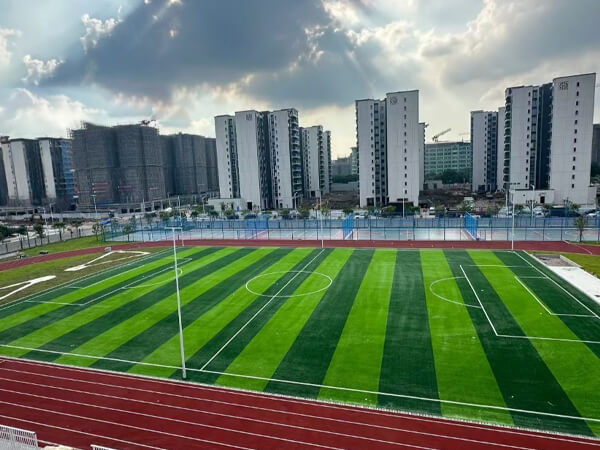
Introduction
Creating a safe, clean, and enjoyable playground is a top priority for kindergartens. With growing concerns about safety, maintenance, and the environment, many schools are turning to artificial turf. This trend is gaining traction because of the numerous benefits it provides, such as improved safety and reduced upkeep.
In this article, we’ll explore the four key reasons why artificial turf is becoming the preferred choice for kindergarten playgrounds. You’ll discover how synthetic grass meets both practical and environmental needs while ensuring a safe, enjoyable space for children.
![XiHY 55mm Soccer Turf pitch XiHY 55mm Soccer Turf pitch]()
1. Enhanced Safety: Soft and Cushioned Surface
1.1 Impact Absorption for Injury Prevention
One of the greatest concerns when designing playgrounds is ensuring the safety of children. Artificial turf stands out because of its superior cushioning properties. The synthetic fibers of turf absorb the impact when children fall, reducing the risk of injuries like bruises, scrapes, and more severe consequences.
In fact, many synthetic turf products are designed to meet safety standards for fall zones, providing a consistent and reliable surface for children to play without the risk of hard, unforgiving ground beneath. Whether children are climbing, jumping, or running, they have a soft landing, which significantly lowers injury rates compared to harder materials like gravel or concrete.
1.2 Consistent and Smooth Surface
Artificial turf provides a consistent, smooth surface that helps prevent tripping accidents. Unlike natural grass or wood chips, which can create uneven surfaces over time, artificial turf remains even and flat, ensuring a safe environment for children. The uniform texture ensures there are no bumps or dips, which is particularly crucial for active children who are constantly moving around.
1.3 Non-toxic and Allergy-Free Materials
Children's health is a top priority, and artificial turf contributes positively by being non-toxic. Unlike natural grass, which can harbor pests or require the use of chemicals like fertilizers or pesticides, artificial turf requires no such treatments. This makes it a healthier option for children who may be sensitive to allergens or chemicals commonly found in traditional playground materials. By reducing pollen and the potential for skin irritation, artificial turf ensures a cleaner, safer environment.
2. Low Maintenance: A Cost-Effective Solution
2.1 No Mowing or Watering Required
Artificial turf offers the advantage of requiring no mowing, trimming, or watering. Traditional grass needs regular maintenance to stay healthy and attractive. However, this is time-consuming and costly for schools. Synthetic grass, on the other hand, needs very little upkeep, saving both time and money. Once installed, it requires only occasional cleaning, reducing the need for costly and frequent maintenance efforts.
Artificial turf's durability and low upkeep also mean fewer maintenance costs over time. Schools can avoid spending money on lawn care professionals, irrigation systems, and replacement sod. Additionally, schools in dry areas, where water conservation is important, can significantly reduce their water usage by choosing synthetic turf over traditional grass.
2.2 Reduced Pest Control and Fertilization Needs
One of the hidden costs of natural grass is pest control. Grass attracts insects and other pests that require ongoing management, often through pesticides. Additionally, fertilizers are frequently needed to keep the grass lush and green. Both pesticides and fertilizers can be harmful to the environment and children's health. Artificial turf eliminates these issues, offering a clean, pest-free surface without the need for chemicals.
By avoiding the need for pest control chemicals and fertilizers, schools can provide a safer, chemical-free environment for children. Moreover, the absence of these substances helps preserve the surrounding ecosystem, reducing the risk of contamination of nearby soil and water.
2.3 Long-Term Durability
Another cost-saving feature of artificial turf is its long-term durability. Unlike natural grass, which can wear out quickly due to heavy foot traffic, artificial turf is built to last for many years. Most synthetic turf comes with warranties of 8 years or more, offering reliable performance without the constant need for replacement. This means significant savings in the long term as schools can avoid the recurring costs associated with re-sodding and turf replacements.
Companies like XiHY Turf, which specialize in high-quality synthetic grass, offer long-lasting solutions designed to withstand heavy use without showing signs of wear. Their turf products are perfect for high-traffic playgrounds, providing children with a consistent and safe surface for years.
3. All-Weather Durability: Year-Round Playability
3.1 Resistance to Weather Conditions
One of the significant advantages of artificial turf is its ability to withstand extreme weather conditions. Whether it’s the scorching heat of summer, the freezing cold of winter, or heavy rain, artificial turf remains resilient. Unlike natural grass, which can get muddy and unusable after rainfall or freeze during winter months, synthetic turf is designed to endure the elements. This makes it an ideal year-round surface for kindergarten playgrounds, ensuring children can play regardless of the weather.
For example, playgrounds with traditional grass often close after heavy rainfall, preventing children from playing outside for hours or even days. However, artificial turf can drain water quickly, allowing for continued playtime shortly after a rainstorm. This all-weather durability makes synthetic grass a practical choice for regions with varied climates.
3.2 Quick Drainage System
Artificial turf comes equipped with a drainage system that allows rainwater to flow through the surface quickly, preventing water from pooling and creating hazardous puddles. In playgrounds with natural grass or wood chips, water can collect, leading to muddy conditions that are not only unpleasant but also dangerous. Additionally, artificial turf's drainage system ensures that playgrounds remain dry, preventing the growth of mold and bacteria, which can be harmful to children’s health. This feature makes synthetic turf a hygienic, low-maintenance surface for playgrounds in both rainy and dry conditions.
3.3 Consistent Appearance
Artificial turf maintains its vibrant green color throughout the year, regardless of weather changes. Natural grass can look patchy, brown, or faded after intense sunlight or heavy rain. Artificial turf offers consistent aesthetics, helping to create a bright, welcoming playground all year long. This makes it an ideal option for maintaining a high-quality playground appearance without the stress of seasonal upkeep.
XiHY Turf's products are designed to retain their lush, green appearance year-round, providing children with an inviting and visually appealing playground. This consistency also reflects the quality of the product, ensuring that the playground always looks its best.
4. Cleanliness and Hygiene: A Healthier Playground
4.1 Mud-Free and Dirt-Free Environment
One of the primary reasons to choose artificial turf for kindergarten playgrounds is its ability to keep children clean. Natural grass can quickly become muddy, especially after a rainfall, leaving children’s clothes dirty and increasing the risk of infections or rashes. Artificial turf, however, has a built-in drainage system that prevents the accumulation of water and dirt. As a result, children can enjoy outdoor play without getting muddy, making it easier for parents and caretakers to keep their clothes clean. Moreover, artificial turf helps reduce the time and effort spent on cleaning clothes and playground equipment. With less mud and dirt, parents and caretakers can focus more on enjoying playtime with the children instead of worrying about cleanup.
4.2 Reduction in Allergens
Playgrounds with natural grass often have high pollen counts, which can trigger allergies in some children. Pollen, dust, and other allergens are common in grassy areas, causing discomfort for children with sensitivities. Artificial turf minimizes these issues as it does not produce pollen, making it an allergy-friendly option. The smooth, synthetic surface reduces the dust and airborne particles that can contribute to allergic reactions.
4.3 Easy Cleaning and Maintenance
Artificial turf is easy to clean and maintain, making it an excellent choice for a hygienic playground. Unlike natural grass, which requires frequent weeding, mowing, and fertilizing, synthetic turf requires only occasional brushing or blowing off leaves and debris. In the case of spills or stains, a simple rinse with water is usually enough to restore the turf’s cleanliness. This makes artificial turf a low-maintenance option for busy kindergarten facilities.
Tip: For a cleaner and more hygienic playground, choose artificial turf to reduce the time spent cleaning and to eliminate the risks associated with natural grass.
| Feature | Artificial Turf | Natural Grass |
| Safety | Soft, impact-absorbing surface | Hard, uneven surfaces |
| Maintenance | Low, minimal upkeep | High, requires mowing, watering |
| Durability | Long-lasting, all-weather | Prone to wear, seasonal issues |
| Cleanliness | Mud-free, easy to clean | Muddy, high maintenance |
| Allergen Control | Allergy-friendly | High pollen, irritants |
Conclusion
XiHY offers artificial turf solutions that provide significant benefits for kindergarten playgrounds.Artificial turf creates a safe, clean, and durable play environment with enhanced safety, low maintenance, and all-weather durability. It reduces allergens, pests, and muddy conditions, making it a healthier choice for children. With long-term durability and minimal upkeep, XiHY turf products are a wise investment for any kindergarten seeking a reliable, safe, and enjoyable playground.
FAQ
Q: What is Artificial Turf and why is it ideal for kindergarten playgrounds?
A: Artificial turf is a synthetic grass surface designed for durability and safety. It is ideal for kindergarten playgrounds due to its soft, cushioned surface that absorbs impacts, reducing injury risks, and requiring low maintenance.
Q: How does Artificial Turf improve safety in playgrounds?
A: Artificial turf provides a cushioned surface that absorbs impact during falls, lowering injury risks compared to harder surfaces like concrete or gravel.
Q: Is Artificial Turf easy to maintain for playgrounds?
A: Yes, artificial turf requires minimal upkeep, eliminating the need for mowing, watering, or fertilizing. It also offers better drainage, ensuring the playground stays clean and safe year-round.
Q: Does Artificial Turf last through all weather conditions?
A: Yes, artificial turf is highly durable and can withstand extreme weather, including heat, cold, and rain, ensuring continuous playtime without the risk of mud or damage.












